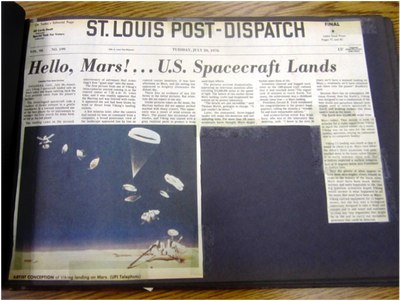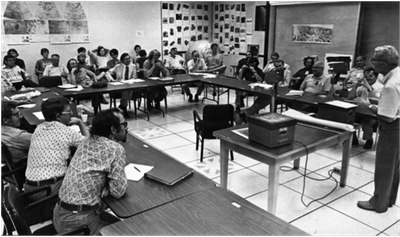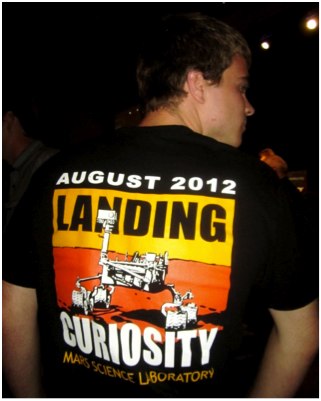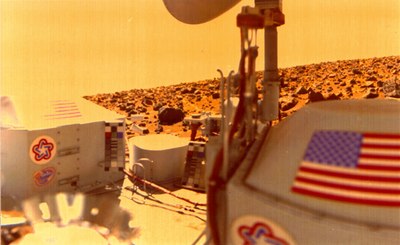Red Planet reduxby Rex Ridenoure
|
| When mailing the application off felt in my bones that I was going to get selected—one of the few times in my life when I felt so sure about something with slim odds. |
Just before the winter holiday break in my sophomore year at Iowa State University in Ames, one of my Aerospace Engineering Department professors who was a co-investigator on Viking handed out a half-page mimeographed notice summarizing an opportunity for “Viking Undergraduate Internships” planned for the summer of 1976, to be sponsored by NASA and the Sloan Foundation from June 1 through September 30 in support of expected landings in July and September. Interns would report to the Jet Propulsion Laboratory in Pasadena for one-month stints to support tasks such as “monitoring TV camera performance, cataloging and evaluating pictures, and scientific analysis of the pictures including search for wind-blown sediment and other moving objects.” Round-trip airfare, living accommodations, and daily transportation to/from JPL would be provided at no charge to the intern, who would also receive a $400 stipend for the month of service—about $2.30/hour for a typical 40-hour workweek.
Being a shutterbug since middle school and also intrigued more about the space vs. aero side of aerospace, I expressed my interest in applying to my professor by his December 20, 1975, deadline, and got the application ready to mail to NASA three weeks later. The NASA application form stated that “this program has been established specifically to involve a small number of deserving undergraduate students in the operational phase of a space mission.”
How cool is that? And not just any space mission, but NASA’s first try at landing on Mars!
For the opportunity presented, described as a “Lander Imaging Internship,” the application form was remarkably short and simple: eight questions to answer about my background and career interests, some science courses to list, internship months to prioritize and two personal references to list. I took my best shot at answering everything sincerely, and when mailing it off felt in my bones that I was going to get selected—one of the few times in my life when I felt so sure about something with slim odds.
Six weeks later a letter from Dr. Thomas A. “Tim” Mutch (the internship program’s brainchild) in the Department of Geological Sciences at Brown University arrived, informing me of my selection as one of 58 students in the Viking Undergraduate Intern Program, selected by Mutch and Carl Sagan from a pool of nearly 600 applicants. Bingo!
 Planetary geologist Tim Mutch, brainchild of the Viking Intern Program. Sadly, he died just four years after the Viking landings while mountain climbing in the Himalayas. (credit: Brown University) |
In the application I had checked the month of July as my #1 choice (as did most other applicants, I suspect), but was assigned the last month, September, joining a dozen other interns. Ten interns were assigned to June (including Andrew Chaikin and Bill McKinnon); 19 reported during July (including Paul Spudis and David W. Thompson); and 16 in August. (I have seen mentions on-line that Phil Christensen, Bruce Jakosky, and Alan Peterfreund were also Viking interns, but they do not appear in the July 30, 1976 NASA press release. Perhaps more were added after this date, or perhaps there was a similar program for graduate students.)
The internships weren’t just for supporting the Lander Imaging team either: other teams included Project Science, Physical Properties, Biology, Molecular Analysis, Meteorology, Orbiter Imaging, Thermal Mapping, Radio Science, Water Vapor, and several other science instrument teams. (A NASA summary of the internship program stated that the Viking Program had a total of 72 science teams.)
For reasons I’ll never know, my assignment was to the Radio Science team. This was in my acceptance letter, but for the next six months until reporting to JPL I received virtually no additional information about what to expect except for basic travel and logistics information.
1976 was long before e-mail and the Internet, so newspapers and magazines were my primary sources of information on how the twin Viking missions were progressing. I had secured a more typical two-and-a-half-month summer internship that summer at McDonnell Douglas in St. Louis, and starting June 19 (a day or so before Viking 1 successfully executed its Mars Orbit Insertion maneuver and some two weeks before the long-planned July 4 landing) I began a scrapbook of clippings from the St. Louis Post-Dispatch sprinkled with a few articles from the Science News weekly magazine and the Sunday New York Times.
| What’s missing from the Viking era, of course, are today’s rather phenomenal flows of readily available information provided by the Internet and related social media tools and apps that we almost take for granted. |
During that hot, humid summer in St. Louis I enjoyed my first experience working in a real aerospace company (re-organizing FORTRAN code used for cruise missile aerodynamics analysis), participated in the 800,000-strong bicentennial celebration under the St. Louis Gateway Arch, and watched the Montreal Olympics on TV. During a lunch-time talk held in one of the large McDonnell Douglas cafeterias, I listened to a not-yet-well-known professor from Princeton, Gerard O’Neill, summarize his audacious vision for huge colonies in space supported by extensive extraterrestrial resource utilization. And I followed the Viking Program.
Through the words of reporters following Viking, I vicariously followed along during the summer as Viking 1 achieved orbit, promptly transmitting images back to Mission Control at JPL which revealed that the intended landing zone was cluttered with “dangerous craters and knobs and steep slopes,” according to an Associated Press article. Mission planners at JPL scrambled to define an alternate site, only to reject it because radar bounces from Earth suggested that the territory was rougher than the original area. Additional images from orbit and hundreds of hours of consideration and debate resulted in the project’s decision to land Viking 1 at Chryse Planitia, the “Golden Plain” of Mars, on July 20.
 Then, as now, Mars landings make front-page news. (credit: From the author’s Viking scrapbook from the summer of 1976.) |
Perusing my Viking scrapbook again, the news headlines and media coverage of Viking 1’s landing appear in many respects to be quite similar to what we all just saw and read about for the MSL landing, including an ample number of front-page color photos from the Martian surface, mission-related illustrations, and quotes from mission leaders and participants, space and biological scientists, NASA officials, cultural commentators, and politicians. What’s missing from the Viking era, of course, are today’s rather phenomenal flows of readily available information provided by the Internet and related social media tools and apps that we almost take for granted: text, images, videos, mission animations, interviews, Twitter feeds, Facebook posts, reader comments, etc. None of this richness existed in 1976, and now my scrapbook and clippings seem quaint in comparison.
Buoyed by success after success during the summer—Viking 2 entered orbit in early August—I couldn’t wait to report to JPL and see with my own eyes what was going on there.
All of the September interns arrived on September 1st, met the intern handlers, completed the hotel room check-in at an older hotel on Arroyo Parkway in Pasadena, and then were bused to JPL to complete an orientation briefing and the badging process at JPL. On September 2nd we all got a JPL tour and dispersed for introductions to and initial organizing meetings with our respective science teams. And on September 3rd Viking 2 landed on Mars.
In my first published article of any kind, “My Month With Viking—Confessions of a Student Intern” (FASST News, 1977 Jan-Feb issue, p. 9), I summarized the experience of being there:
It was Friday, September 3rd. Everyone sat silent and motionless, on the edge of their chairs—eyes glued to the closed circuit T.V. screen. The picture was focused on the man from the Lander Performance and Analysis Group, who would be the first person to know if Viking 2 had landed safely, or crashed, on Mars. Earlier that day, the high-rate data link between the Lander and Orbiter had been lost due to a jolt during separation. The only indication of a safe landing would be a pre-programmed change in the data rate from the Lander at the instant of touchdown. The data from the Lander was coming so slowly on the low-rate link that this rate change was the only sure signal of a safe landing—everything else had been unknown for the past four hours. The long, tense wait between separation and landing ended at 3:58 p.m. that afternoon—the mission controller on the screen shouted, “There it is! There it is! Touchdown!” The data rate changed and there were now two landers safely on the surface of Mars!
Later that night—well after midnight, in a darkened room somewhere in the bowels of the Viking mission control area—several of us new interns were allowed to huddle directly behind Lander Imaging team leader Alan Binder (years later the prime mover behind the Lunar Prospector mission) as he peered at his console while it slowly revealed the first image from the Viking 2 lander. It took nearly 20 minutes for the entire image to display, and we were all captivated and mesmerized for every second. Binder and a few of his team members were doing instant science as the first strip of the image (from the left side) scrolled in. What a way to kick off an internship!
 The first image returned from the Viking 2 lander, 1976 September 3. (credit: NASA) |
It would have been nearly impossible to top Day 3 of my thirty days, so I did my best to focus on keeping my eyes and ears open for interesting activities and events as the two missions played out. Being on the Radio Science team was actually fortuitous because this team’s busiest time was not scheduled until the Viking Extended Mission, starting two or three months later. Thus, though the team consisted of 13 scientists and engineers, only four were at JPL during the entire month I was there. Several dozen other JPLers and contractors were tasked with supporting the team as needed, but most of these hadn’t been fully ramped up yet and I only met with a few. So, after completing my assigned tasks such as flagging good vs. bad radio tracking data from stacks of computer print-outs or preparing some plots or figures for an upcoming presentation, I actually had a fair amount of time to roam around and sit in on the varied and numerous mission- and science-related meetings and briefings, often ongoing seven days a week—and always encouraged by the Viking team.
 Sitting in on a daily Viking science briefing (back row, second from left, with four other interns). At the head of the table facing presenter Norm Horowitz are Carl Sagan (left), Klaus Biemann (center) and Gentry Lee (right). (credit: From the excellent yearbook-style chronicle The Vikings of ’76, by Hans-Peter Biemann, p. 135.) |
The three weeks or so of listening to briefings on science findings, watching the Viking mission planners discuss and debate a maneuver strategy, or soaking up the latest Viking press conference was a major influence on how I subsequently viewed space projects as a team effort, punctuated as most are by a few exceptionally bright and talented leaders able to ingest, digest, and assess all of the information presented and arrive at reasoned decisions about what to do next. The Viking internship set me on course to become a spacecraft systems engineer, mission engineer, mission architect, and project leader, with a strong interest in and enthusiasm for doing things for the first time and for missions beyond Earth orbit.
| Somewhere, maybe Tim Mutch and Carl Sagan and many others behind the Viking Internship Program who did not live to see Curiosity’s landing are smiling too. |
It was a treat on August 5 to watch the MSL Entry, Descent, and Landing team during their anxious “seven minutes of terror” and then relish in their spectacular success of landing Curiosity so close to the intended landing target. Though the team atmosphere, pre-landing frayed nerves, post-landing jubilant high-fives, and media attention during the Viking and MSL landings looked so similar, these events were strikingly different. The Viking landing ellipse, even when dropping the EDL system from Mars orbit, was some 174 x 62 miles (278 x 99 kilometers)—roughly the size of Los Angeles, Orange, and San Diego counties combined. The 1997 Mars Pathfinder ellipse covered half this area, and subsequent MER and Phoenix landings targeted zones not even 10% as large as Viking. And with all of the advanced Earth-to-Mars navigation skills, understanding of Mars as a planetary system, operational orbital assets and EDL techniques employed by the MSL team, the targeted landing zone for Curiosity was a mere 0.4% of Viking’s—about the combined size of JPL neighbors Pasadena, La Cañada, and Altadena. Surely during the next 35+ years of Mars mission activity we’ll develop the methods and experience to repeatedly execute pinpoint landings to one or more common targets on Mars.
I enjoyed the MSL EDL show at Planetfest 2012, organized by The Planetary Society and held at the Pasadena Convention Center. Our large hall was packed 2,000-strong, while other halls and auditoriums in the Pasadena and Los Angeles area held thousands more. It put a smile on my face to realize that what I and perhaps only a few thousand others were privileged to experience in 1976 can now be experienced by many millions, with a much more immersive, detailed awareness of what’s happening at far-away Mars.
As the Curiosity landing celebrations were breaking up after midnight, I noticed a young college-age student wearing an attractive MSL landing T-shirt, and took this photo:
 |
I asked him, “Say… where did you get that cool T-shirt?”
“Oh, this? JPL gave all of us interns one at the end of our internship! And isn’t it cool!?”
Somewhere, maybe Tim Mutch and Carl Sagan and many others behind the Viking Internship Program who did not live to see Curiosity’s landing are smiling too.
